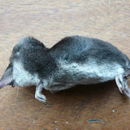Biology
provided by Arkive
This largely nocturnal species (5) inhabits burrows during the day and emerges to feed on invertebrates at night (2). They dive under water to obtain prey such as freshwater shrimps and caddis fly larvae, and the occasional frog newt or small fish may be tackled (2). When diving, the water-resistant fur holds bubbles of air that give the shrew a silvery appearance (4). They can also hunt on land for worms, beetles and other terrestrial invertebrates (4). Shrews are well known for their voracious appetites; water shrews must eat about half their own body weight in food every 24-hours to stay alive (6). Unusually amongst mammals, this species has venomous saliva, which aids in stunning prey (2). This species frequently grooms itself carefully, especially after diving. Water is removed by shaking and scratching, and also by squeezing through their narrow burrows (6).
Water shrews are solitary animals, and hold territories (2). They do not hibernate, but are active throughout the year (2). Breeding takes place between April and September (5); during this time 1 or 2, but occasionally 3 litters of 3-15 young are produced in a nest of woven grasses (2) after a gestation period of 14-21 days (4). The lifespan is short (between 14 and 19 months); adults die after breeding, and the young breed the following year (2). Predators include tawny owls, barn owls, foxes, predatory fish and kestrels (2).
Conservation
provided by Arkive
Water shrews are never very abundant (2), and their populations have a patchy distribution and are short-lived (5); it is therefore very difficult to detect whether the species is threatened (2). Schedule 6 of the Wildlife and Countryside Act protects all shrews from trapping without a licence (3).
Description
provided by Arkive
The water shrew is the largest of the British shrews (2); it has black upper parts and a whitish underside, between which there is a clear demarcation (4). Typically for most shrews, the snout is long and the eyes and ears are small (2). The fur is short and dense, and there are often tufts of white around the eyes and on the ears (2). Stiff hairs border the feet and form a keel on the underside of the tail (2), which aid in swimming (4). This species is a 'red-toothed shrew'; iron is deposited in the enamel of the tooth-tips, making them more resistant to wear-and-tear, and giving them a red appearance (6).
Habitat
provided by Arkive
This semi-aquatic species is found close to water, in stream banks, ponds, rivers, reed-beds and fens, with a particular preference for watercress beds (2). However, it may also occur away from water in damp woodlands (4), and hedgerows (5).
Range
provided by Arkive
Occurring throughout much of continental Europe, water shrews have a wide distribution in England, are quite common in Wales but rare in areas of northern and western Scotland (5). It is also found on several large offshore islands, including the Isle of Wight, Anglesey, Skye, Mull and Arran. It is absent from Ireland, the Channel Islands and the Scillies (2).
Status
provided by Arkive
Partially protected in the UK under Schedule 6 of the Wildlife and Countryside Act, 1981 (3). Listed under Schedule III of the Bern Convention, and classified as a Species of Conservation Concern under the UK Biodiversity Action Plan, although not a priority species (7).
Threats
provided by Arkive
Drainage schemes (2) and the modification of riverbanks and riparian vegetation resulting from river engineering and agricultural intensification are likely threats (5). As this species is at the top of a semi-aquatic food chain, it may be highly susceptible to the effects of agrochemicals. Furthermore, any contaminants entering the water can reduce prey availability (5). Loss of continuous hedgerows and a decline in hedgerow quality may also be a problem, as for many species of mammal (5).

